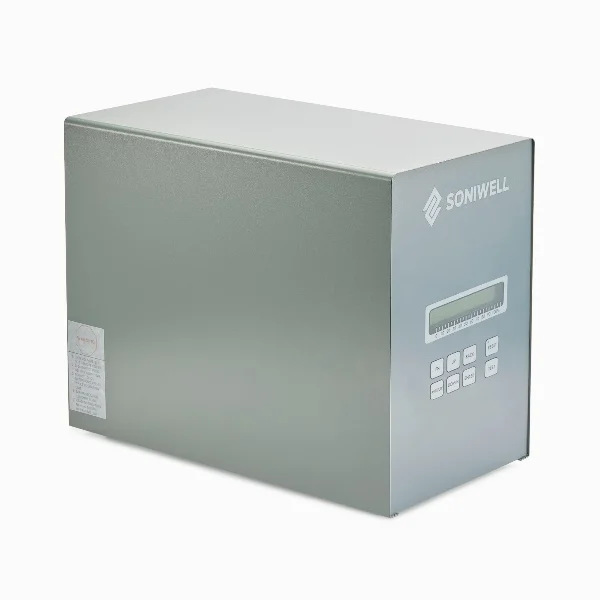Ultrasonic technology has revolutionized various industrial and laboratory processes, from cleaning and welding to precision cutting. Among its many forms, the ultrasonic generator 40kHz stands out for its balance between efficiency, control, and versatility. In this blog post, SONIWELL, a high performance ultrasonic rubber cutting system manufacturer, will share the advantages of ultrasonic generator 40kHz for sale, its applications, etc.
How 40kHz Ultrasonic Generator Works
The principle of the ultrasonic generator 40kHz lies in converting low-frequency electrical energy (typically 50/60Hz) into high-frequency electrical energy, which is then transformed into mechanical vibrations. These high-frequency vibrations—generated by an ultrasonic transducer—create rapid oscillations that can be applied to various media, including metals, plastics, rubber, and liquids.
In simple terms, the ultrasonic generator acts as a bridge between electrical and mechanical energy. When powered, it outputs high-frequency signals that drive the piezoelectric transducer, converting them into mechanical vibrations at 40kHz (40,000 cycles per second). This vibration is transmitted through a horn or cutting blade, enabling precise actions such as ultrasonic welding, rubber cutting, and cleaning.
The 40kHz frequency is particularly significant because it provides a balance between penetration power and surface precision. While lower frequencies (20–30kHz) deliver stronger vibrations for heavy-duty applications, 40kHz generators produce finer, more controlled energy suitable for delicate operations and high-precision environments.
Advantages of Using 40kHz Ultrasonic Generator
1. High Energy Conversion Efficiency
A 40kHz ultrasonic generator efficiently converts electrical energy into mechanical motion, ensuring minimal energy loss. This results in consistent vibration amplitude and stable operation, even during continuous industrial use.
2. Precise and Clean Processing
The 40kHz ultrasonic frequency produces microscopic vibrations that allow for fine, burr-free processing—ideal for cutting materials like rubber, synthetic fibers, and composites. In ultrasonic cutting, this means edges remain clean and sealed, reducing the need for post-processing.
3. Low Noise and Reduced Tool Wear
Compared to mechanical cutting, ultrasonic vibration cutting generates minimal friction and noise. The contact between the tool and material is significantly reduced, prolonging blade life and maintaining consistent cutting performance over time.
4. Versatile Frequency Adaptation
Modern digital ultrasonic generators offer adjustable parameters, enabling operators to fine-tune output power, frequency tracking, and amplitude according to material characteristics. This flexibility ensures stable resonance at 40kHz even under varying load conditions.

Applications of 40kHz Ultrasonic Generator
Ultrasonic Rubber Cutting
One of the most prominent uses of the ultrasonic generator 40kHz is in rubber and synthetic material cutting. Rubber is known for its elasticity and resistance to traditional blades, but ultrasonic vibration enables smooth, precise slicing without deformation or sticking. The high-frequency energy reduces resistance, making it ideal for cutting automotive seals, gaskets, and silicone products.
Ultrasonic Cleaning Systems
In ultrasonic cleaning applications, 40kHz is a widely preferred frequency. It produces microscopic cavitation bubbles in the cleaning fluid, which implode and dislodge contaminants from surfaces. The 40kHz level provides a good compromise between cleaning power and delicacy, effectively cleaning precision parts, electronic components, and medical instruments without causing surface damage.
Ultrasonic Welding and Bonding
The ultrasonic generator 40kHz is also used in plastic welding, textile bonding, and packaging sealing. The high-frequency energy softens material interfaces, allowing molecular fusion without adhesives or heat damage. This method ensures fast, reliable, and environmentally friendly bonding.
Laboratory and Medical Equipment
In scientific and medical fields, 40kHz ultrasonic systems are used for cell disruption, emulsification, and degassing. Their precise control and stable vibration make them essential in laboratories for sample preparation and in medical devices for non-invasive cleaning or disinfection.
Design and Performance Features of Modern Ultrasonic Generators
Modern 40kHz ultrasonic generators integrate intelligent control systems to optimize performance. Typical design features include:
-
Automatic Frequency Tracking: Maintains resonance frequency despite load or temperature changes.
-
Digital Power Regulation: Provides consistent amplitude and energy stability.
-
Overload and Overheat Protection: Extends the life of both generator and transducer.
-
Compact and Modular Design: Facilitates easy integration into existing cutting, cleaning, or welding systems.
Some advanced models feature microprocessor-controlled interfaces, enabling users to monitor frequency, power output, and load conditions in real time. This ensures higher reliability, reduced downtime, and improved operational precision.
Role of 40kHz Ultrasonic Technology in Modern Industry
As automation and precision manufacturing continue to evolve, 40kHz ultrasonic generators play a critical role in improving production efficiency and quality. Their ability to process a wide range of materials with minimal mechanical stress makes them indispensable in automotive, electronics, textiles, food processing, and medical industries.
Compared to conventional cutting and cleaning methods, ultrasonic technology offers contactless, energy-efficient, and contamination-free solutions. The 40kHz frequency in particular provides the optimal balance between speed, control, and safety—making it the go-to choice for industries seeking cleaner, quieter, and more sustainable operations.
Conclusion
The ultrasonic generator 40kHz is a cornerstone of modern precision processing. By converting low-frequency electrical energy into powerful ultrasonic vibrations, it enables efficient cutting, welding, cleaning, and bonding across multiple sectors. Its combination of energy efficiency, accuracy, and adaptability continues to drive innovation in material processing and manufacturing.
Whether for ultrasonic rubber cutting, delicate cleaning, or precision bonding, investing in a high-quality 40kHz ultrasonic generator ensures superior results and long-term operational reliability. As industries move toward cleaner and smarter production, the significance of ultrasonic systems—especially those operating at 40kHz—will only continue to grow.
www.soniwellgroup.com
SONIWELL